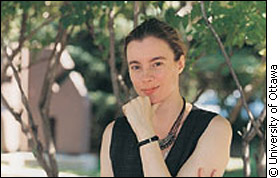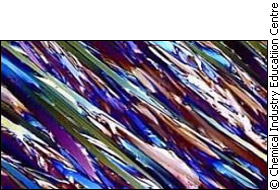Deryn Fogg is designing better engines. But they won't go in any car or machine. And she doesn't work in a garage or a mechanic's shop. Deryn Fogg builds her engines in a small lab at the University of Ottawa. Instead of working with a drill, electrical wires or wrenches, Fogg's toolbox contains flasks, safety goggles and Bunsen burners. And instead of a toolbox, all of these things are kept in drawers under a laboratory bench. The only thing that Fogg's lab may have in common with any mechanic's garage are the tunes blaring from the portable CD player, an eclectic mix from the Beatles to Daftpunk, to an impressive jazz collection. "The first thing I did when I got here was to get a CD player for in here," Fogg says standing in the lab. It's a curious place, with shelves lined with small bottles of colourful powders. What stands out most about it is a big glass cabinet in the middle of the room, with what looks like two arms sticking out of it. It's actually a high-pressure unit where all the chemicals are kept, and the arms are really two gloves that you put your hands through to access the chemicals. Everything must be kept as unexposed to air as possible.
This is where where Fogg and her team of researchers try to design better catalysts, which are the engines in the world of chemistry. It's cutting edge research in a field that has rapidly been moving forward over the last decade. Catalysts are substances that drive chemical reactions. The process,
called catalysis, is behind almost all chemical reactions, both naturally
occurring and man-made. As a natural phenomenon, catalysis has been
known since the early nineteenth century. But it wasn't until the twentieth
century that catalysis was manipulated in the laboratory. In Chinese, the symbol for the word catalyst is the same as the symbol used for marriage broker, and that's exactly how catalysts can be thought of. A catalyst is a substance that brings molecules together in a reaction. The catalyst itself doesn't get involved in the reaction, or marriage. It can be used over and over again and won't affect the overall reaction.
All of this takes a certain amount of energy, in turn the reaction itself gives off energy. Since the catalyst facilitates a reaction, it takes away some of the energy required to get the reaction going. That also means is that less energy is produced in the overall reaction. "It's such a beautiful process," Fogg says. "It just goes round and around and around." Sitting in her office, Fogg is surrounded by chemistry books, student's papers and her own collection of art. She's constantly pulling her long hair back as she tries to explain the methods behind complex chart, sketches and graphs. There's a sign taped to a filing cabinet that she puts on the door sometimes. The sign says "Thinking in progress." "You always want to identify a problem that no one else has figured out," she says. Fogg's research in the field is building on important advancements. In fact, the 2001 Nobel Prize for chemistry was awarded to three scientists for their work with catalysts.
Normally, catalysts attract a specific molecule to their surface because of their shape. Like two puzzle pieces, only one kind of molecule will fit with one catalyst. However, traditional catalysts are made up of many different atoms. Fogg has found a way to construct a catalyst that is only a single molecule, and with an even more specific puzzle piece. It will attract only the molecule for which it is designed. This part of the catalyst, the puzzle piece, is called the active site, and it's the level of control that Fogg has over the active site that makes her work so interesting. By designing the active site of a catalyst so that it will bring together very specific molecules, Fogg can practically create custom-designed catalysts.
Mirror images Although all molecules of the same substance, like the amino acid alanine, are all made up of the same atoms, they can differ in arrangement. So out of two alanine molecules, they will be the same in shape, except one will be the mirror image of the other, just as a right hand is the mirror image of a left hand. In all chemical reactions only one of the hands is needed. Receptors in the body will only accept, for example, the right-handed shape of the molecule, and the left-handed one exists without reacting. This can be dangerous, particularly in medication. If a drug has both the right and left hand versions, then the left-handed molecule remaining in the body can do serious harm.
The Nobel Prize in chemistry went to researchers who found a way to produce only right-handed molecules using a catalyst. Fogg's research operates on the same principle. She is trying to design active sites on her catalyst that will only attract the right-handed molecules. By doing so, she is designing more efficient engines. Her research can be applied to all sorts of fields, including pharmaceuticals, which can use her research to make more effective drugs with fewer side-effects. What's more, by changing the active site only slightly, the same molecular catalyst can be used again for a different reaction in the same process. That's very exciting news for chemists who are trying to build very complex compounds. "It used to be that, in order to get one compound, a chemist had to use a catalyst for one reaction. Then, he would have to take what he got from that and add a different catalyst to get another reaction, and then he'd have to keep doing that with different catalysts until he got the compound he wanted," Fogg explains. "We're doing the chemistry on the catalyst instead," Fogg says. A
slight alteration of the active site will bring about a different reaction.
By transforming the active site, one catalyst can be used for several
jobs. Fogg and her researchers patented this finding last year. Fogg's catalysts, which are mixtures of different coloured powders and liquids, are actually complex structures. "I think some people are drawn to inorganic chemistry for its sheer range of colours," Fogg says. The important player in Fogg's research is an obscure metal, way down on the periodic table, right under Iron, called Ruthenium. Fogg's face lights up as she talks about Ruthenium as if it's an old friend. "It's a beautifully complex metal. It's so rich in catalytic chemistry," says Fogg, "it's such a joy to work with." It's hard to imagine that the lavender powder in little flasks lining the storage cabinet is that beautifully complex metal. When she draws them out, those structures look like honeycombs littered with lines and dashes representing bonds.
"It's merely structure to keep the whole thing together," Fogg says. Somewhere in this honeycomb mass is the Ruthenium molecule, the active site, represented by its letters Ru. It's on this metal that Fogg builds the active site. Sketched out on
paper, the catalyst design looks like a giant honeycomb, made up of
all kinds of carbon rings, with some hydrogen here and there. Fogg uses nuclear magnetic resonance imaging (MRI) to take pictures of her products both at the beginning and end. Most of her research time is spent staring at the computer print-out from the machine where she tries to figure out the resulting chemical structure. The print out is a series of wavy lines on a graph — it looks almost like an electrocardiogram. Despite the tediousness of the work, there's an air of excitement about it. "We're sticking together entities that never existed before," says Fogg, "sometimes nature may have other ideas," she laughs. Fogg's brings together both fundamental and applied research, which she says keeps her work interesting. Her greatest joy comes from solving puzzles that unlock the secret world of chemistry — secrets that have the potential to better people's lives.
|
|
|
Learn
more about catalysis |


